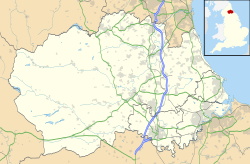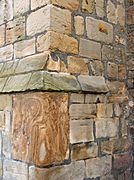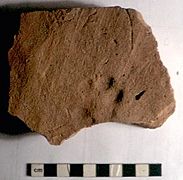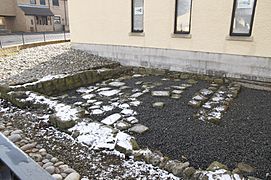Concangis facts for kids
Quick facts for kids Concangis |
|
|---|---|
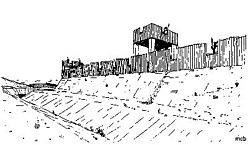
What the early defences at Concangis may have looked like
|
|
| Place in the Roman world | |
| Province | Britania |
| Administrative unit | Britannia Inferior |
| Stationed military units | |
| — Legions — | |
| II Augusta ? | |
| — Alae — | |
|
|
| — Numeri — | |
| Numeri Vigilum | |
| Location | |
| Coordinates | 54°51′24″N 1°34′20″W / 54.85659°N 1.572263°W |
| County | County Durham |
| Country | England |
| Reference | |
| UK-OSNG reference | NZ270512 |
Concangis was an ancient Roman fort, also known as a castra. It was located in a Roman area called Britannia Inferior (Lower Britain). Today, its ruins are found in Chester-le-Street, County Durham, England. People now call it the Chester-le-Street Roman Fort. It's about 6 miles (10 km) north of Durham and 8 miles (13 km) south of Newcastle upon Tyne.
Contents
What Does the Name Concangis Mean?
The name Concangis comes from an old language called Common Brittonic. We're not completely sure what it means. Some experts think it might come from a word like *concos or *cancos, which means "horse."
A Look at Concangis History
The Roman fort of Concangis was built to the east of other forts like Longovicium (in Lanchester) and Vindomora (in Ebchester). It was also about 8 miles (13 km) south of Pons Aelius (which is now Newcastle upon Tyne).
Concangis was not directly on the main Roman road called Dere Street. This important road connected forts near Hadrian's Wall to Eboracum (York). However, Concangis was close to another road, Cade's Road, which might have linked York to Newcastle. It's also thought that a smaller road might have connected Concangis to Dere Street, but this hasn't been fully proven.
Archaeologists found part of a bridge over the Cong Burn stream. This suggests that Concangis was connected by a bridge to the fort at Vindomora (Ebchester) to the west.
Concangis is mentioned in two old Roman documents. One is the Notitia Dignitatum from the 4th or 5th century. The other is the Ravenna Cosmography from the 7th century. These documents list Roman forts and areas.
Why Was Concangis Built Here?
The Romans chose a great spot for Concangis. It sits on a high hill, looking over the Wear valley to the east and the Cong Burn stream to the north. This kind of high ground was perfect for Roman forts because it gave them a good view and made it easier to defend. The road going north to Newcastle passed west of the fort, making it easy for the Romans to watch who was coming and going.
The fort covered about six and a half acres. It was first built with wood and earth (turf and timber) around 70 AD. The Legio VIIII Hispana (Ninth Hispanic Legion), a Roman army unit, likely built this first version. Later, in the early 2nd century, the fort was rebuilt using stone. The Legio II Augusta (Second Augustan Legion) probably did this work. This was around the same time that Hadrian's Wall was being built, and Legio II also helped with that famous wall.
What Did We Find at Concangis?
Archaeologists have done excavations (digs) at Concangis in 1978 and again in 1990-1991. Sadly, much of the old fort is now underneath the modern town of Chester-le-Street. So, there isn't much left to see. However, a small part of the officers' living quarters has been dug up and is on display.
During the digs, they found many interesting things. These included pottery, fancy dishes, coins, animal bones, and even a cheese press! One very cool find was a tile with a dog's footprint on it.
They also found altars, which are special stones used for religious offerings. Some altars were dedicated to Roman gods like Mars (the god of war) and Apollo (the sun god). Others were for Celtic and German gods, like Digenis and Vitiris. Many altars found here were dedicated to gods who looked after retired soldiers. This suggests that a lot of former military men lived at Concangis.
You can still see two large stones in the church of St Mary and St Cuthbert. These stones have special holes called "lewis holes" that were used to lift them. This strongly suggests they were originally part of the Roman fort and were reused when the church was built.
Who Guarded Concangis?
An old stone inscription tells us that the Legio II Augusta built or rebuilt the fort. However, legions usually built the forts, but other units called Auxilia were the ones who actually lived in and guarded them.
Another incomplete inscription mentions an "Alae Antoninae" (Antonian Wing). This was likely a cavalry unit that did patrols and helped fix things like water pipes (aqueducts) and toilets (latrines). Because the inscription is damaged, it's hard to be sure which unit it was. But based on other finds, it was probably the Ala Secundae Asturum Antoniniana (Second Wing of Antoninian's Asturians). This unit was involved in Emperor Septimius Severus's military campaigns in Caledonia (Scotland). They were also stationed at other forts, like Lindum (which is now Lincoln).
A tile found at Concangis has the letters "NV" on it. This suggests that a unit called the Numeri Vigilum was stationed here in the 4th century AD. This unit was like a company of watchmen or police. The leader of this unit at Concangis was even mentioned in old records as the "Prefect of the Company of Watchmen from Concangis" under the Duke of the Britains.
Gallery
See also
 In Spanish: Concangis para niños
In Spanish: Concangis para niños


